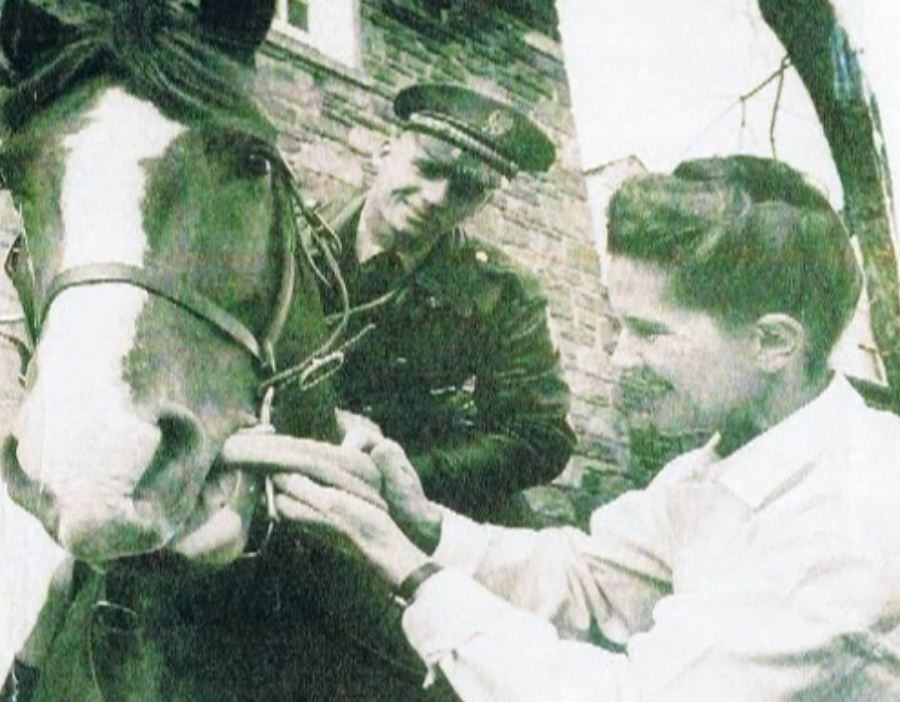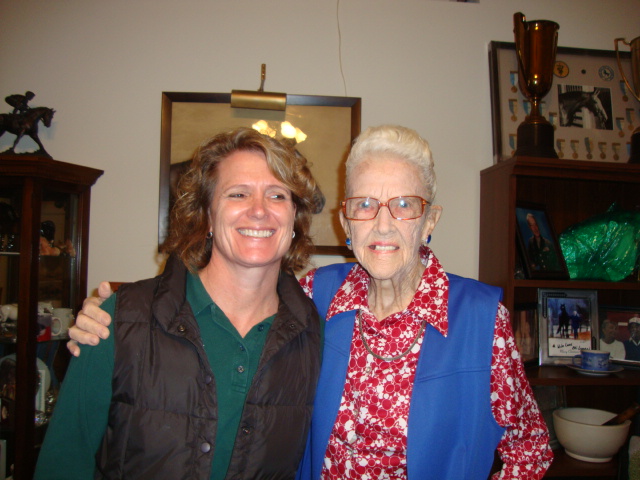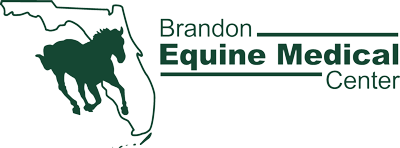Help for Sick Horses in a Surgical Center
Tampa Bay Times, July 5, 2013
Companion Horse Medical Coverage Options Expanding
The Horse, July 31, 2017
Laser Surgery Restores Sight in Blind Horse
Horse Talk, September 11, 2007
A Life of Abundant “Firsts”
In 1957, in a world dominated by male veterinarians, M. Phyllis Lose broke barriers by becoming the first female equine veterinarian. On September 30, 2019 Dr. Lose passed away at the age of 93. What follows is an interview conducted in 2015 during a visit between Dr. Leann Kuebelbeck and Dr. Lose.
According to 2012 AVMA statistics, 54% of all veterinarians in the United States are women. Of those veterinarians, there are 3,821 Equine Veterinarians with 47.9% of them being women. Certainly, the field is as close to being an even playing ground amongst the sexes as you can get. Having a woman veterinarian treat and/or operate on your horse is almost expected. But back in 1957 that was not the case. Then, only a handful of women were small animal veterinarians and they were relegated to the classroom or the office. The percentage of equine veterinarians that were male was 100%. But that all changed when the M. Phyllis Lose graduated from the University of Pennsylvania Veterinary School Class of 1957 as the first female equine veterinarian and, that very same day, began her practice by opening the first equine veterinary clinic to be founded, owned and operated–by a woman. Her entire career, spanning over 50 years, she never worked for anyone but herself.She was well prepared for the challenges of running an equine practice having owned and operated a 20-horse boarding business since the age of thirteen. And there’s more, by the time she was nineteen years old she was the first woman, and youngest person in U.S. racing history to earn a trainer’s license for both the Thoroughbred racehorse industry and the National Steeplechase and Hunt Association.Not impressed yet? Here are more of Dr. M. Phyllis Lose’s firsts and accomplishments:
- Served 25 years of show duty including 20 years as the official Veterinarian at the Devon Horse Show.
- Served for 19 years as the Philadelphia Mounted Police Department’s Veterinarian.
- Competed in and won at shows in Fox Hunting, Racing, Steeplechase, Hunters and Jumpers. Among her many wins are Show Hunter High Score State Champion for two years and In-hand Classes High Score State Champion for three years.
- Provided veterinary services to the Barnum and Bailey Circus, Russian Circus, Italian Circus, Philadelphia Zoo, and the Lipizzaner Stallions.
- Provided hospital services and pastures for injured or retired police horses.
- Earned the distinction of owning the finest privately owned equine hospital in the United States.
- Established the Equine Veterinary Medical Museum, the first museum of its kind.
- Was the first woman member of the American Association of Equine Practitioners (AAEP).
- Diagnosed and confirmed the first case of equine encephalomyelitis disease in Pennsylvania.
- Developed surgical procedures for the correction of club-footed foals, the removal of ovarian tumors, and the removal of urinary bladder stones.
- Developed techniques for cataract removal in foals and geriatrics, bilateral guttural pouch patency and for treating navicular syndrome.
- Author of numerous scientific papers and books including the breeding bibles of horse owners: Blessed are the Brood Mares and Blessed are the Foals.
You would expect a woman of these many significant accomplishments, the breaker of numerous glass ceilings, to be, well, a bit full of herself. Nothing could be farther from the truth. When Dr. Leann Kuebelbeck, herself an equine veterinary hospital and practice owner, sat down with Dr. Lose during a recent interview, it was quickly discovered that this 88-year-old woman with the sparkle in her eyes of a teenager and the enthusiasm of a young veterinary school graduate, is extraordinarily humble and even a bit shy about sharing her accomplishments. Over coffee and cookies, Dr. Lose opened up and what follows are excerpts of that interview.
Did being a woman offer you any advantages?
I had every advantage. I had a champion jumper who made me famous, made me look good. Oh, she [Cassadol] was a dear. Everyone knew Cassadol. And I was born just at the right time. All these other women were trying to prove their worthwhile and I came along and just stepped into place. There weren’t any others and I thought why not; I was a stubborn little girl. I had wonderful parents! At 13 I went to them and said what do you think about me opening a boarding stable, there’s this property I saw [sic]. Instead of saying no that’s crazy, my mother said ‘we’ll go look tomorrow.’ And that was her attitude, it was always ‘go look.’ What a mother and a father. You think you’ve done these things but you stand on their shoulders. You don’t do it alone.
What were some of the most difficult hurdles for women?
I didn’t find difficult hurdles, no. There were hurdles, but I didn’t find them difficult to overcome. It was approach and attitude. I didn’t have resentment. I didn’t have an ego, you weren’t allowed to have an ego.
You became a veterinarian when men dominated the field; now women make up the vast majority of equine practitioners. Tell us about those early days being a female equine practitioner and what drove you to break that barrier?
There were women veterinarians, three or four, and they either went into academia, they stayed at school, or they went into small animal practice for somebody else. There were no women that were really pioneers. And oh dear, an equine veterinarian–out of the question! The horsemen said ‘I wouldn’t have a woman in my breeding shed.’ There was one man who I knew and respected and I thought he respected me but I was sitting on my mare one day and he said ‘you know you’re ok but I’d never call you.’ That was when I was first trying to gain admittance to veterinary school. He said ‘I’d never call’ you but you know he did and I turned out to be his veterinarian. I became one of them; I joined in and didn’t claim to be better than them. Not that I wasn’t competitive, I wanted to win. Competition is good. When someone got in the way, I took another approach.
You are also credited with being the first woman to open an equine surgical hospital, something that Dr. Kuebelbeck certainly can relate to. You must feel a special connection to her and other women who have taken the same path.
Oh, I do, I do. Boy, when I found out about Dr. Kuebelbeck I thought wow–look at what she’s done, I’m so proud of her.
How did you get started?
When I graduated from veterinary school I sent out announcements. And I knew everybody and stayed in my home area. We [with sister Norma] had a farm with 28 box stalls, I went to the track and rehabbed racehorses through the winter and earned money for vet school. I then started the practice right there. I cleaned it out and painted everything white, put stocks in, and holding stalls. It was my little clinic. Then I bought a table and in those days with the army anesthesia [chloral hydrate] it was a challenge. Mostly in those days, I took the hoses out to the grass, where it was clean, and that way I had space to drop them down with the army anesthesia, and that way I kept them down, then it was hard to monitor them. Then gas anesthesia came along. Can you imagine keeping a 1200lb horse down with army gas, I had to be fast. When I think about it, it was pretty primitive. And yet, oh Lord, we were lucky. If you care, if you care about your patient and not only the patient, but the owners. They didn’t teach us that in veterinary school, that every patient had an owner and I made lifelong friends with owners of patients. It is just fantastic.
When you became a veterinarian, men dominated the field, now women do.
Isn’t that wonderful?
You wrote, “Blessed are the Brood Mares” in 1978 and then followed that up with “Blessed are the Foals” in 1987—- What inspired you to write each of them?
I wrote them heart to heart, horseperson to horseperson. I interposed incidences and stories, how I learned and certain points to make it interesting, not just like a textbook.
What is the biggest mistake that horse owners can avoid when they decide to breed their mare?
This sounds elementary, but try to have an experienced equine veterinarian examine their mare. They can avoid so many problems. It’s amazing how I found so many tumors and they’d have to stop there. An example, I went in on a farm one time and they said we’re having problems with our mare, she’s a good mare but we can’t get her to conceive. So I slipped the spec in and she did not have a cervix. I’d never seen it before and I’ve never seen it since. You see one in a lifetime and at least I was able to tell them the news, bad news, but that they could stop trying.
Aside from your books, what’s the most important thing that horse owners should have on hand when their mare is in foal?
If they can, sharpen their perceptions. Three weeks before the prescribed foaling date, keep a chart. Every time you bring her in for the night mark her heart rate, the color of her gums, and respiration. Then stand from the front to the back and notice the pendulous abdomen you want to see it transverse, bulge on each side. And note the mammary gland and the vulva. Forget the front end, the back end is most important. Know the position of the foal, the mammary gland, and the vulva. You can tell practically within hours when they are going to deliver. Sharpen your knowledge; know your mare. Measure the length of the vulva. Have on hand iodine for the navel, lots of dry towels to rub them off really good, and of course a telephone in case you run into trouble. When the mare is foaling you can see the bulge and the little feet, which should be directed downward. If you see those feet directed the other way you know you are in trouble.
If lucky enough to be present when a mare is delivering, how does one know when to stay back and observe and when to intervene?
If they know the normal progression of things they can stand back and watch without intervening. That’s the wonderful thing. Once the mare’s water breaks that’s the moment of truth and the awful thing about the mare is once that happens she’s going to deliver no matter what. Other species they can go on forever, but if the mare doesn’t deliver within 20 minutes of when she breaks the water, then there is going to be trouble. If you see the mare break the water, then she’ll circle around and drop down. When she drops down she’ll be on her sternum but then she’ll roll over and that’s the moment of truth. That’s when she is going to deliver and you’ll see a bulge. Now if you don’t see this white glistening sac, the amnion if you don’t see that with the foot enclosed, and this sounds cruel, but get her up. Get her up no matter what, because it’s not coming. Believe it or not, by being cruel, by forcing her to her feet the foal is so full of fluid it may slip back just enough that if a foot is lodged it will come loose and then, maybe she’ll get back down and deliver ok. I’ve seen it happen.
You wrote that “cows and women are tough and mares are delicate.” Can you elaborate on that?
Cows and women are tough!! You know I had a call once on a cow, and he wasn’t a regular client. I made my rounds and finally got to see his cow 10 hours later and delivered a live calf! I couldn’t believe I was delivering a live calf 10 hours afterward. That wouldn’t have happened with a mare! But women and cows can have labor for a very long period of time.
What was it like in those early years? Did you have someone to help you with those calls or was it just you?
No, it was just me. I spent maybe one night a week in my bed. For 50 years I was on call and I always hit the ground running. I had outfits of zippers, all zippers to make it easy to get on. Physically, I think it did me good. I’m 88 and I get around really good!
You’ve dedicated your life to being an equine veterinarian. How do you feel about your clients?
I learned to love them and they learned to love me. I spent more time on their farms than I spent at home!
It’s obvious from your writings, that you consider broodmares to hold a very special place in the world. You’ve attended to many, many broodmares and foals. Do any stand out in your memory and why?
They all do, every one of them. A mare, once she starts, is going to deliver. We just hope everything is in order and that all the many, many intricate things are in place. God above, or somebody, brings it all together. I’d say 90% of mares deliver in the normal way. But the other 10%…..
What advice would you give equine veterinarians coming out of school today?
It’s corny, but I am corny. Treat their client’s horses as if it were their own. Any horse that I was called on was immediately my own. Care about them and things will work their way. Don’t be afraid of the owners, show them you are sincere and they will treat you with respect. I treated the horses as my own. That’s my advice.


Expert equine care in Brandon, FL.
From our board-certified horse surgeons and board-certified internists to our professional and courteous staff, at Brandon Equine Medical Center, we are committed to the health and well-being of all breeds and sizes of horses. In the field, as an outpatient, or when admitted to the horse hospital, we treat every horse like our own and every client as the most important.
Contact Info
Phone: 813-643-7177
Fax: 813-643-5877
Email: info@brandonequine.com
Hours
Saturday & Sunday: Closed
Emergency care available: 24/7/365
Location
605 E Bloomingdale Ave
Brandon, FL 33511
Click here for directions.
Have a question?
Our team is here to help! Complete the form below to get in touch.
If this is an emergency, please call us directly at 813-643-7177.

Ready to come see us?
Request your next appointment online in minutes from any device. We look forward to seeing you soon!
